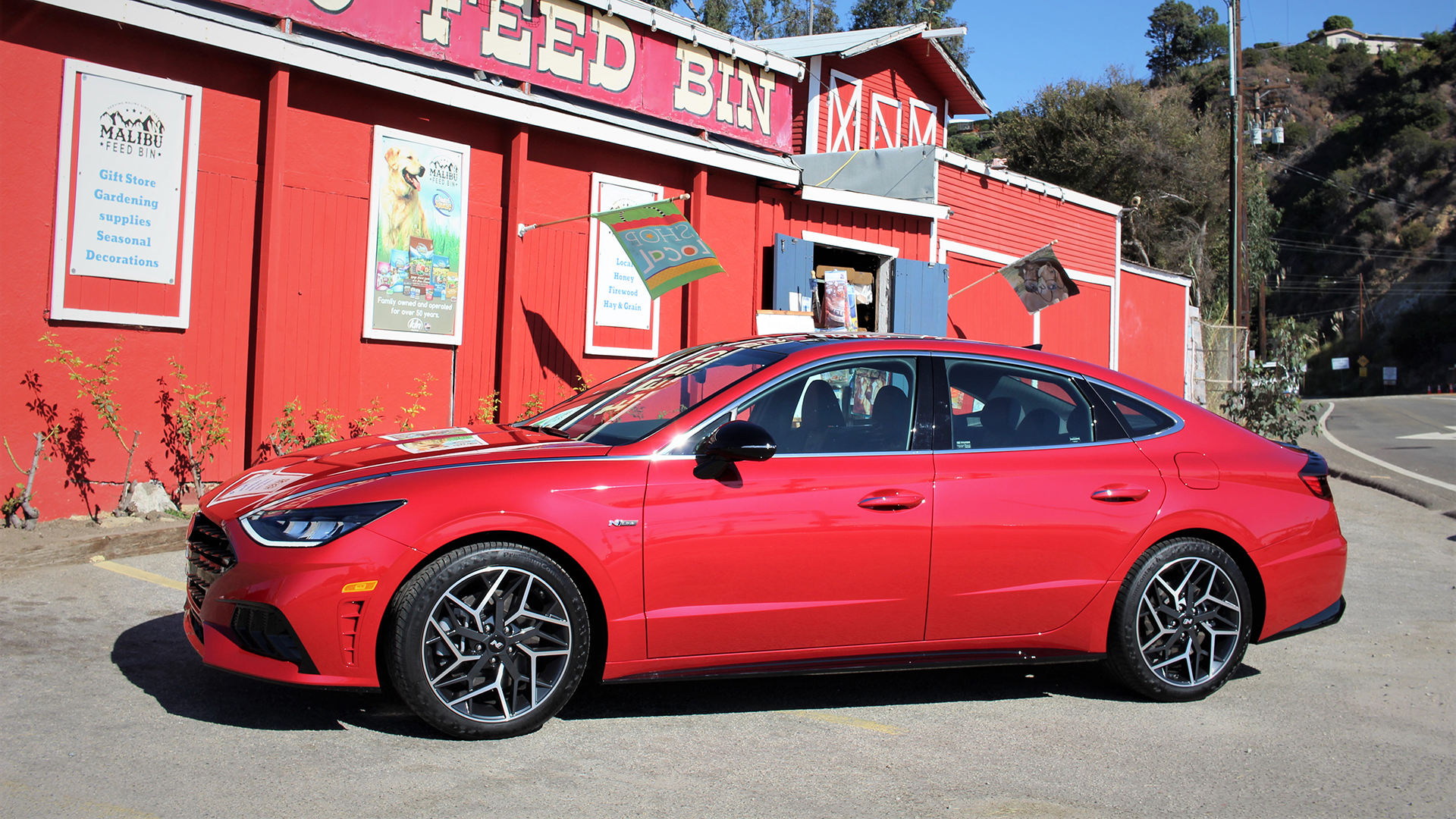BMW and Mercedes Benz do it. So why not Hyundai? And by “it,” I mean a Diet Coke version of the full-on performance cars, with a lot more go and some of the looks but with all the punch—or the price tag. The German automakers have been doing this for some time with their M Sport and AMG Line cars. That’s what the Hyundai N Line is—nicer and faster than the base car, but nothing extreme. Or particularly expensive. Given how hard the Hyundai Group has been raiding both BMW’s personnel file and performance playbook as of late, it definitely makes sense.
This brings us to the 2021 Hyundai Sonata N Line, which packs a surprising punch of 290 horsepower and 311 pound-feet of torque from its turbocharged four-cylinder, a new 2.5-liter that should find its way into other Hyundai and Kia products. With a new cylinder head and other upgrades, this engine is a huge leap from the standard Sonata’s 191-horsepower 2.5-liter four-cylinder engine or its optional 180-horsepower turbocharged 1.6-liter four-cylinder.
2021 Hyundai Sonata N Line, By The Numbers
- Base price (as tested): $33,300 ($34,395)
- Powertrain: 2.5-liter turbocharged four-cylinder | 8-speed automatic transmission | front-wheel drive
- Horsepower: 290 at 5,800 rpm
- Torque: 311 lb-ft at 1,650-4,500 rpm
- EPA Fuel Economy: 23 mpg city | 33 highway | 27 combined
- Cargo Space: 16 cubic feet
- Curb Weight: 3,552 pounds
- Quick Take: The Sonata N Line gives us a lot more than we were expecting, but a little less than we wanted.
In nearly every way, it’s a big boost for the attractive but humble Sonata, which starts at $23,600 in base form. Priced at $33,200 (add $995 for freight), or $33,400 with Continental 19-inch summer tires, the Sonata N Line has lots of other equipment that makes the price a bargain, most notably the new eight-speed, wet dual-clutch transmission.

Unlike a dry dual-clutch transmission, the wet N DCT uses oil to enhance lubrication and cooling, employing an electric oil pump for increased thermal endurance and reduced parasitic drag on the powertrain. There are two married clutch assemblies, one for odd gears and one for even gears. The clutch actuator assembly utilizes a lightweight electric motor-driven system. This transmission is very similar to the one offered in the Veloster and Elantra N models. Shifting is direct and intuitive, and in the manual-shift mode, it’s particularly satisfying. You even get rev-matching and launch control.
Outside, the Sonata N Line has a noble profile and nose, but in the rear, it has a slightly melted look that appears to have been designed by committee. Still, the car has an impressive stance—I can’t wait to see lowered-with-bigger-tires versions of the car after the aftermarket gets hold of it.

Inside, the Sonata N Line has an attractive, means-business cockpit highlighted by a horizontal 10.25-inch screen that controls multiple functions. The digital instrument display changes when switched through driving modes, which include Normal, Sport, Sport +, and Custom. Different selections alter the steering weight and the speed and strategy of the transmission’s shifts.

There’s the usual long list of safety and convenience features, plus the optional smartphone-based Hyundai Digital Key. Digital Key uses a dedicated mobile app, Near Field Communication (NFC), and Bluetooth Low Energy (BLE) technology to allow a Sonata to be unlocked, started, and even driven without a physical key, using applicable Android smartphones.
At the center of the dashboard, a large 10.25-inch HD screen enables passengers and a full-stop driver to interact easily with the audio-video and navigation functions. This screen can also accommodate a split-screen function that allows audio and navigation to be displayed simultaneously. There’s also three years of complimentary Blue Link services. The sound system was very good—not much new there. Hyundai’s Smart Sense aggregates all the expected safety features, such as smart cruise control with stop and go, and lane-keeping assist.
Upfront, you get sport seats and N Brand red stitching throughout. The seats, with Nappa leather bolsters and suede inserts, are fine, but a little more lateral support wouldn’t hurt. Aluminum pedals are a nice touch – Hyundai clearly is straddling the line between performance and luxurious comfort, and pretty well hits the target. Rear seat room is fine for two six-footers, less fine for three. Trunk space, at 16 cubic feet, is ample.

Based on the Sonata SEL, the N Line gets you unique 19-inch alloy wheels, 245/40 R19 all-season tires or those optional 245/40 R19 summer tires; unique front and rear fascias, a modest rear spoiler, a panoramic sunroof, gloss-black side mirrors, a dual exhaust with quad tips and LED taillights. There are modest side skirts, too. You get N badging in case all that isn’t enough to differentiate the N Line from the SEL.

On the road, the N Line’s suspension, which, aside from beefier chassis bushings and other chassis stiffening is straight from the SEL, handles all but the largest potholes with aplomb. Cornering is crisp but not on par with a genuine performance car – this is a compromise, and feels like it. Brakes are bigger than the SEL’s, and have a solid, linear feel. That also describes the steering, in Sport, at least. Sport is a versatile setting—good manners, a smooth ride, but still some punch when you need it. It’s a very quiet car, with minimal wind noise and only some tire roar when on porous surfaces.
In any configuration, the Hyundai Sonata is a serious competitor in the midsized sedan field, which admittedly is a field starving from product drought. The N Line makes us happy, lite: Give us the Sonata N, Hyundai. You know you want to.
Got a tip? Send us a note: tips@thedrive.com
